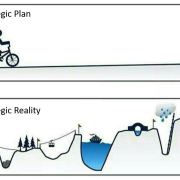Why putting your business on autopilot is a GOOD thing
We’ve all heard the expression that a team or an individual was “operating on autopilot”. Usually this means operating in an automatic, unthinking manner – it’s a bad thing. However, I believe that creating and engaging an autopilot for your business is a good thing. It ensures that the business stays on course no matter what the external influences are. It also gives the business’s leadership – its pilot, if you will – the time and attention necessary to take a longer term view and plot the optimum course for the business.

In today’s world of constantly changing business environments, we often define effective leadership as staying on top of every little shift in these winds of change and constantly counter-steering to keep the organisation firmly on course. We make monthly and quarterly business targets the top priority because we value staying on course – following the plan – over reaching the destination in the most effective way possible.
The problem is that this perspective consumes a tremendous amount of leadership energy and attention – energy and attention that is diverted from:
- Getting ahead of changes in the business climate rather than reacting to them once they’ve happened.
- Creating space within the business for exploration and innovation that will delight your customers.
- Looking for operational improvements that will ensure that the organisation is set up to be as efficient and effective as possible.
- Ensuring that your business stays on the best possible course to reach its destination.
- Continuously adapting the current strategic priorities and so that your team’s activities provide the greatest value in delivering the business outcomes.
This is where your business autopilot comes into play. It doesn’t mean that you allow your attention to wane. It is a means of re-directing your energy and attention – your leadership bandwidth – to higher value pursuits. All the while confident in the knowledge that your people will maintain the current operational direction.
Before we can think about engaging autopilot, we need to understand what an autopilot is and how it works.
Autopilot provides a dynamic response to course-changing conditions
Many view an autopilot as something that is quite static – where the control surfaces and throttle are locked into a fixed position as a means of maintaining a direction and speed. If this were the case then external currents and pressure changes would continually push the plane off its intended course. The pilot would have to periodically reset these controls on a new flight path once he realised they were no longer on course. How dramatic this course correction needs to be depends on the amount of disruption from these external forces – the level of turbulence in the air.
In truth, an autopilot is a very dynamic system. It takes in data from a range sources both inside and outside the plane and then processes this data to continuously make small adjustments to the throttle, elevators and rudder. In fact, it uses external conditions to anticipate change and make predictive course corrections. Staying on course by constantly making small adjustments based on external and internal influences, means the plane flies much more efficiently, creates the least possible disruption to the passengers and allows the pilot to stay focused on reaching the destination by the most effective means possible.
Unfortunately, a great many businesses use this static approach to setting their strategic and operational direction. They are so focused on maintaining their controls that they miss the disruptive external influences that are taking them off course until major correction is required. They fail to read the horizon because they don’t lift their view.
Creating a business autopilot means engaging the skills and experience of your people to keep things on course
At the centre of an autopilot for your business are your people. The collective experience and thinking of your teams is the autopilot’s ‘central processor’. The skills and capabilities of your staff that provide day-to-day value to your customers are your ‘control surfaces’. Meaningful, real-time information on how the organisation is performing at both the business and operational levels as well as how you are perceived by your customers makes up the all-important data on which your people’s actions are based.
By engaging your teams in a creative and collaborative way you motivate them to make those small course corrections every day in pursuit of your strategic direction. Interestingly, you get them engaged by giving them something compelling to be engaged in; by providing the opportunity for their efforts to have purpose and actively progress the strategic imperatives for the business.
To do this there are some foundational elements that you need to put in place:
- Build a framework that makes course correction easy. Put in place operational practices that embed continuous improvement so that doing their work every day is actually making the business – and their lives – better. Maintain a portfolio of improvement projects that are constantly adapting to changes in the business climate. Finally, provide data that gives your teams the information they need to know how to improve, not just how the business is performing.
- Create empowered teams. Engaging your business autopilot means turning over a significant element of operational control to your people. To do this effectively, you need to organise them into small cross-functional teams that have the autonomy to make business adjustments that keep the business on course. Give them this freedom by showing that you trust them. Then maximise their ability to repay this trust by supporting and enabling the activities and processes they put in place.
- Maintain direction by giving your organisation a course to follow. To create strategic direction, you need to establish a course for your business that sets out strategic objectives – waypoints for getting to your business destination. This means mapping out a strategy for reaching your business objectives and establishing priorities for executing that strategy. In this article I talk about how this strategy needs to include both deliberate and emergent elements as well as the needs to regularly revisit your strategic priorities.
The power of this type of autopilot is that the organisation’s leadership knows that the business can run effectively without daily hands-on operational interaction. It allows the business to operate in a more resilient manner by taking advantage of full capability of its greatest asset – its people.
In an interview on HBR IdeaCast podcast, Jason Fried, co-founder and CEO of Basecamp, says that one of his favourite indications that things are working as they’re supposed to is when he sees work go out the door that is really good and he didn’t even know it was happening.
Engaging your autopilot gives the business leadership the bandwidth to find the best possible course
By better utilising the full depth and breadth of your organisation to maintain the operational direction of the business, leaders free up their time, attention and energy to design the best possible course for the business. They can scan the horizon for possible storms and headwinds and determine whether it is best to steer over, around or through them. They can look for favourable currents and tailwinds that allow the business to accelerate or gain altitude into clearer air. They will be able to better assess the effectiveness of business operations and engage with their teams to determine where efficiencies can be gained.
There is a specific type of leadership that is required to utilise autopilot in the most effective way – what I refer to in this article as ‘transformational leadership’. This is where you begin to truly expand your leadership influence by taking advantage of the full leadership capabilities of every level of the organisation.
In this way, you can continuously set the best possible course based on the business environment you are operating in. This means selecting the highest priority projects to be in your adaptive project portfolio. You can set up and re-align the organisation for the smoothest, most efficient flight for the current conditions. You can set your strategic direction based on an understanding of the business climate you are operating in instead of re-establishing your direction because the winds of economic change have blown you off course, or a competitive disruption creates a storm that batters your craft.
Questions for consideration:
- How do stop spending too much time steering your business so you know whether you’re navigating the right course?
- How do you shift your people from being the control surfaces that you constantly adjust to being the autopilot that maintains the business course?
- What could you do to ensure you see the storms and the jet streams that are appearing on the horizon rather than trying to keep your business ‘straight and level’ as you fly through them?
Never miss a post – sign up to my fortnightly newsletter here.








Leave a Reply
Want to join the discussion?Feel free to contribute!